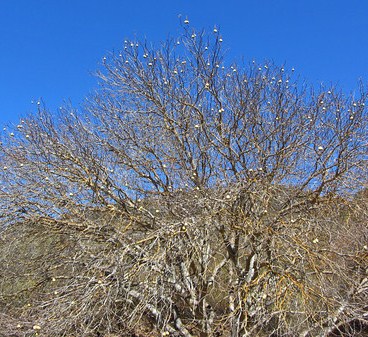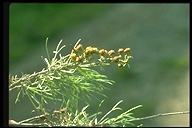
Drought Dormant Buckeye
Deciduousness
In our Mediterranean climate, some trees and bushes drop their leaves in an effort to cope with the drought-like conditions of hot dry summers. As a result, instead of the "normal" rapid growth one expects in warmer and wetter climates, summer is the time for California chaparral plants to slow down their growth. If they didn't, they would soon dry up from lack of water and die. Loss of leaves during the summer is called drought deciduousness. By contrast, in the eastern US, deciduous trees lose their leaves in winter and growth is slowed because plants do not readily absorb cold snow and water. But show vigorous growth in the warm wet summers.The warm or hot dry air we have in our Open Space is more difficult for plants to deal with than cold moist air. High air temperature increases evaporation of water from leaf surfaces and soil moisture rapidly disappears (see the cracked mud in footpaths). Many local plants do not receive rain until the weather has again turned cool, so growth is again slowed because of this reduced temperature. The best growth season is the spring when the air warms and the soil is moist.

Tiny sagebrush leaves conserve moisture
Brother Alfred Brousseau
© 1995 Saint Mary's College of California
Deciduousness is another adaptation for certain plants that have to conserve energy. Making new leaves each year is a very energy-intensive process. Deciduous trees slowly grow leaves that produce food and energy for growth. Evergreen trees that do not drop their leaves are ready to produce energy as soon as winter rain starts.
Our major deciduous plants are: Blue Oaks, Valley Oaks, Buckeyes, and Poison Oak. Poison Oak is especially hardy since it is only a shrub or vine: rarely is it large enough to be called a tree with a vigorous root system.
Jerry Fritzke
June 22, 2003




 Join/Renew
Join/Renew Donate
Donate Volunteer
Volunteer Maps
Maps Newsletter
Newsletter Facebook
Facebook
